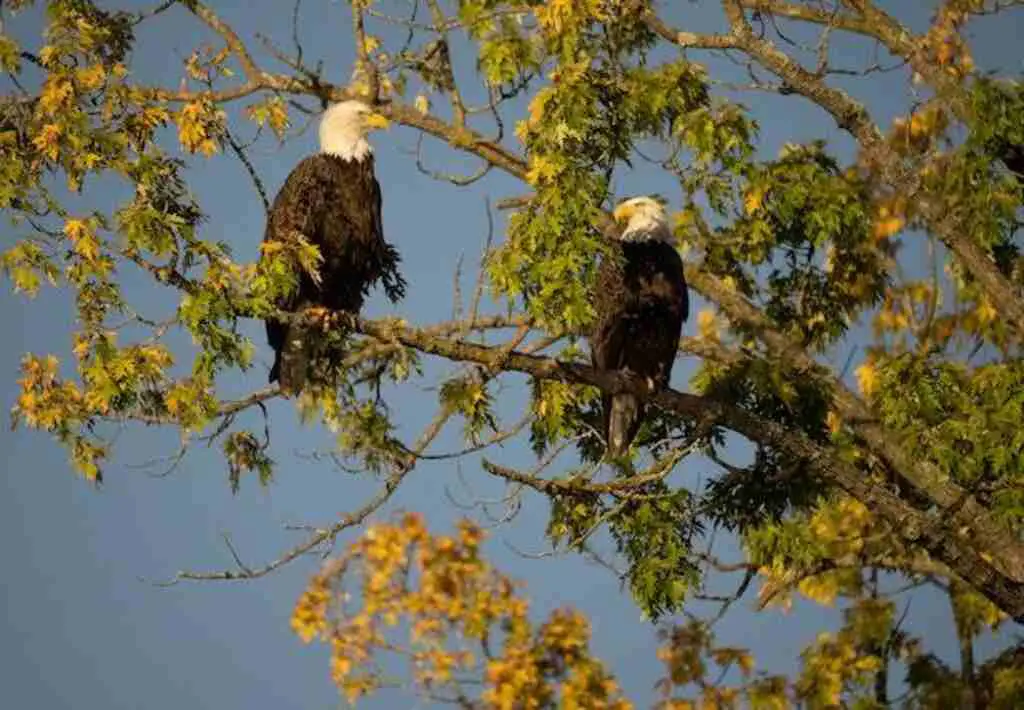Do Eagles Eat Geese? In a world of predator-prey relationships, this age-old question captivates nature enthusiasts. Eagles, symbols of strength, and geese, epitomes of unity, engage in a fascinating dance.
Delve into their diet, behavior, and evolutionary adaptations as we uncover the captivating interplay between these majestic species.
Unravel the mysteries and join us on a scientific journey of debunking myths and unraveling the captivating relationship between eagles and geese.
Table of Contents
- 1 Key Takeaways
- 2 Do Eagles Eat Geese
- 3 The Diet of Eagles
- 4 The Behavior of Geese
- 5 Interactions Between Eagles and Geese
- 6 Predation as a Natural Process
- 7 Adaptations and Defense Mechanisms
- 8 Factors Influencing Prey Selection
- 9 Geographic Variations in Predation Patterns
- 10 Conservation and Management Considerations
- 11 Misconceptions and Myths
- 12 Frequently Asked Questions
- 12.1 How do geese defend themselves against eagle attacks?
- 12.2 What are some common misconceptions about eagles and geese interactions?
- 12.3 Are there any management strategies in place to protect geese from eagle predation?
- 12.4 What factors influence the selection of geese as prey for eagles?
- 12.5 Do geese have any adaptations or defense mechanisms to avoid being caught by eagles?
- 13 Conclusion
- 14 Author
Key Takeaways
- Eagles and geese have intricate relationships that affect population dynamics and ecosystem balance.
- Eagles primarily prey on fish and small mammals, while geese are herbivorous.
- Geese employ defensive strategies like exceptional eyesight, large group formations, and aggressive behaviors to deter eagle attacks.
- Eagles may opportunistically prey on geese, but it is not common.
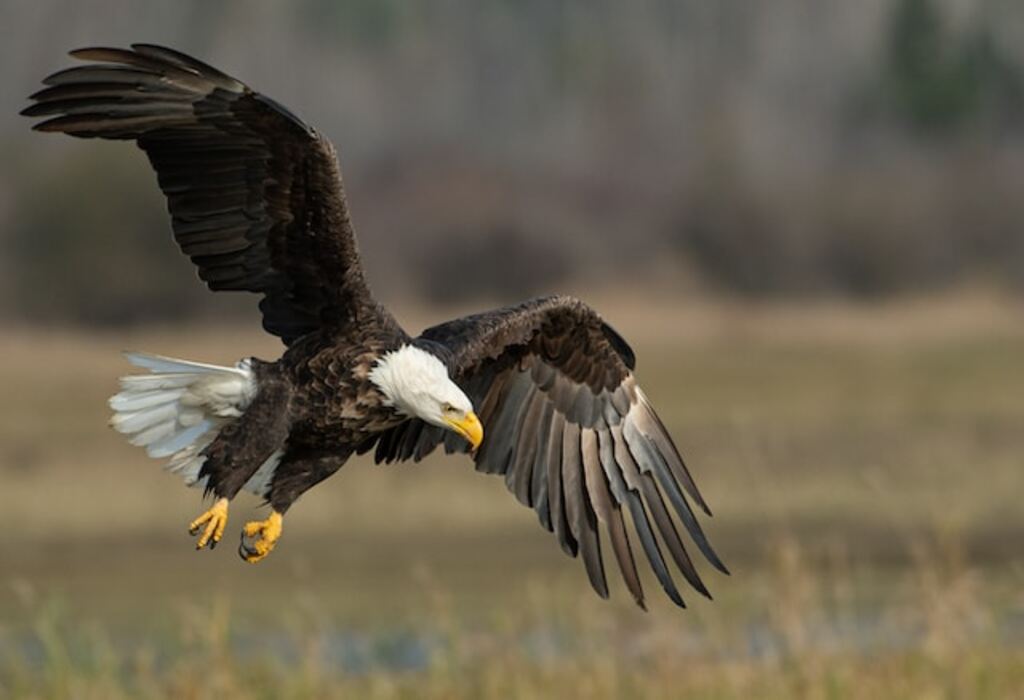
Do Eagles Eat Geese
Yes, eagles do eat geese. As formidable aerial predators, eagles possess the strength and hunting skills to capture and consume geese.
Their keen eyesight and powerful talons make them capable predators in the natural world. The eagle’s diet includes a variety of prey, and geese are one of their potential targets in their quest for sustenance.
The Diet of Eagles
The diet of eagles encompasses a variety of prey, including geese. Eagles are opportunistic hunters and will feed on a wide range of animals that are available in their habitat.
However, the availability of certain prey, such as geese, can be influenced by factors such as pollution and climate change.
Pollution, particularly in aquatic environments, can lead to a decrease in the population of fish, which are important prey for eagles.
Additionally, climate change can alter the availability of geese and other prey species by influencing their migratory patterns and breeding success.
As a result, eagles may need to adapt their hunting strategies and explore alternative food sources.
Understanding the impact of pollution on eagle diet and the role of climate change in altering prey availability is crucial for their conservation.
In the subsequent section, we will explore the behavior of geese and how it relates to their interactions with eagles.

The Behavior of Geese
Geese are known for their remarkable migratory behavior, often traveling long distances to find suitable breeding and feeding grounds.
They exhibit complex social behaviors and communication patterns, forming strong bonds within their flock and displaying synchronized movements during flight.
Geese also have various vulnerabilities and employ defensive strategies to protect themselves from predators, such as honking loudly and aggressively posturing to deter potential threats.
Geese as migratory birds
Migratory geese, like nomads of the sky, travel vast distances in search of favorable habitats. Their migratory patterns are influenced by various factors, including seasonal changes, availability of food, and breeding requirements.
Geese populations exhibit dynamic fluctuations, with some species traveling in large flocks while others prefer smaller groups.
The table below provides an overview of different geese species and their preferred migration routes:
| Species | Migration Route |
|---|---|
| Canada Goose | North America |
| Barnacle Goose | Europe |
| Snow Goose | North America |
| Greylag Goose | Europe |
| Emperor Goose | Alaska |
Understanding these migration patterns allows researchers to monitor population dynamics and assess the overall health of geese populations.
Geese communicate and exhibit social behaviors within their flocks, which will be discussed in the subsequent section.
Social behaviors and communication
Social behaviors and communication among geese are essential aspects of their interactions within flocks and contribute to the overall dynamics of their populations.
Geese employ various communication strategies to maintain social cohesion and ensure effective coordination during migration and foraging.
These strategies include vocalizations, body postures, and visual displays.
Vocalizations, such as honking, serve as a means of communication to signal danger, maintain group unity, and establish territory boundaries.
Body postures, such as head bobbing or neck stretching, are used to convey dominance or submission within the flock.
Visual displays, such as synchronized wing flapping or swimming in V-formation, enhance aerodynamic efficiency and facilitate navigation.
Geese exhibit complex social dynamics, forming strong pair bonds and engaging in cooperative breeding. These behaviors foster group cohesion and increase survival rates.
Transitioning to vulnerabilities and defensive strategies, geese have evolved mechanisms to protect themselves from predators and environmental threats.
Vulnerabilities and defensive strategies
Vulnerable to predation and environmental threats, geese have developed defensive strategies to ensure their survival. Geese are susceptible to attacks from predators such as eagles, foxes, and coyotes.
To counter these vulnerabilities, geese employ a variety of defensive techniques. One such strategy is their ability to detect potential threats through their exceptional eyesight and acute hearing.
They often form large groups or flocks, which enhances their chances of detecting predators early and allows for collective defense.
Additionally, geese are highly territorial and will vigorously defend their nesting sites and offspring against intruders.
They exhibit aggressive behaviors, including hissing, honking, and biting, to deter potential threats. Geese are also known to utilize their wings to strike adversaries, further enhancing their defensive capabilities.
By employing these defensive strategies, geese are better equipped to avoid predation and ensure their survival.
| Vulnerabilities in Geese | Defensive Strategies of Geese |
|---|---|
| Predation by eagles, foxes, and coyotes | Exceptional eyesight and acute hearing |
| Vulnerability during nesting period | Formation of large groups or flocks |
| Threats to offspring | Aggressive behaviors and wing strikes |
These defensive strategies not only provide geese with a greater chance of survival, but they also allow for fascinating interactions between eagles and geese.
Interactions Between Eagles and Geese
Interactions between eagles and geese are often marked by intense competition for food resources. Geese migration patterns play a significant role in shaping these interactions.
During migration, geese typically form large flocks, which may attract the attention of eagles searching for prey.
In response to this threat, geese display various defensive strategies. They often employ vigilance behavior, where some individuals stand guard while others feed.
Geese also utilize their powerful wings to take flight quickly, escaping potential attacks from eagles.
Additionally, geese may exhibit mobbing behavior, where they gather in large numbers and aggressively confront the eagle, hoping to intimidate it and deter its predatory intentions.
Furthermore, eagles employ various hunting techniques when targeting geese, including aerial attacks and surprise swoops.
These interactions highlight the complex dynamics between eagles and geese, showcasing their adaptability and resourcefulness in the face of competition and predation.
Transitioning to the subsequent section, predation is a natural process that shapes ecosystems.
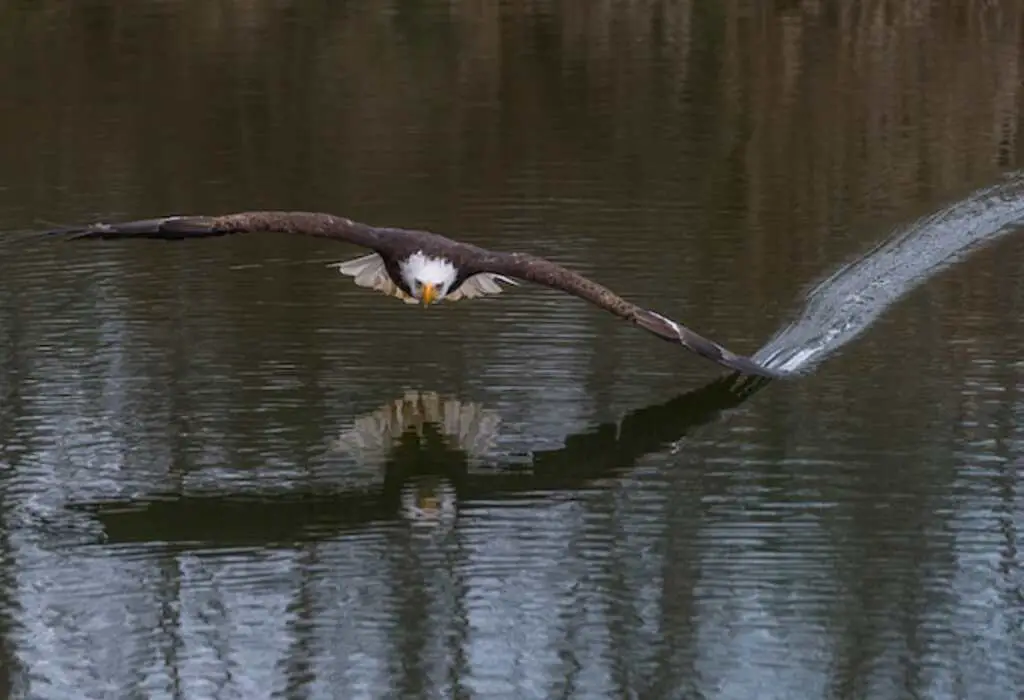
Predation as a Natural Process
Predation plays a crucial role in maintaining ecosystem balance by regulating population sizes and controlling the distribution of species.
In the case of eagles and geese, predation by eagles helps to maintain a stable population of geese by controlling their numbers and influencing their behavior.
Additionally, eagles are not the only predators that target geese, as other species such as foxes, coyotes, and raccoons also pose a threat to the geese population.
The role of predation in maintaining ecosystem balance
The presence of predators within an ecosystem is crucial for maintaining a balanced and diverse community of species.
Predation plays a significant role in regulating population sizes, particularly in the context of geese migration.
The interaction between predators and their prey is a fundamental component of predator-prey dynamics, shaping the structure and function of ecosystems.
Predators such as eagles exert selective pressure on geese populations, targeting the weak, sick, or young individuals.
This predation acts as a mechanism to remove individuals that may otherwise compete for resources or transmit diseases within the population.
By controlling geese populations, eagles help maintain the overall health and balance of the ecosystem.
Understanding the impact of predation on population dynamics of both eagles and geese provides insights into the intricate relationships within ecosystems, facilitating effective conservation and management strategies.
Impact on population dynamics of both eagles and geese
Population dynamics of eagles and geese are profoundly influenced by their intricate relationship, ultimately shaping the health and balance of the ecosystem.
Eagles, as top predators, play a crucial role in maintaining ecological balance by controlling the geese population.
The presence of eagles exerts a strong predation pressure on geese, leading to a decrease in their numbers. This predation affects the geese population dynamics in several ways.
Firstly, it reduces their overall population size, preventing overpopulation and resource depletion.
Secondly, it alters the spatial distribution of geese, as they tend to avoid areas where eagles are more abundant.
This redistribution can have cascading effects on other species and overall ecosystem structure.
Eagle predation on geese impacts population dynamics, revealing the delicate interplay between predators and prey for a balanced ecosystem.
Transitioning to the subsequent section, it is also worth exploring other predators that target geese.
Other predators that target geese
The impact of predators on the population dynamics of geese is not limited to eagles alone. There are other predators that also target geese, which adds complexity to the dynamics of their populations.
One such predator is the coyote, known for its opportunistic hunting strategies. Coyotes are known to hunt in packs, which enables them to take down larger prey like geese.
They employ various hunting techniques, including stalking, chasing, and ambushing their prey.
Another predator of geese is the fox, which also exhibits cunning hunting strategies.
Foxes are known for their ability to sneak up on their prey and pounce on them, using their agility and speed to their advantage.
These other predators contribute to the natural balance of the ecosystem by exerting pressure on the geese population.
Understanding the hunting strategies employed by these predators is crucial in comprehending the overall dynamics of geese populations.
This knowledge sets the stage for exploring the adaptive and defensive mechanisms developed by geese to counteract these predation pressures.
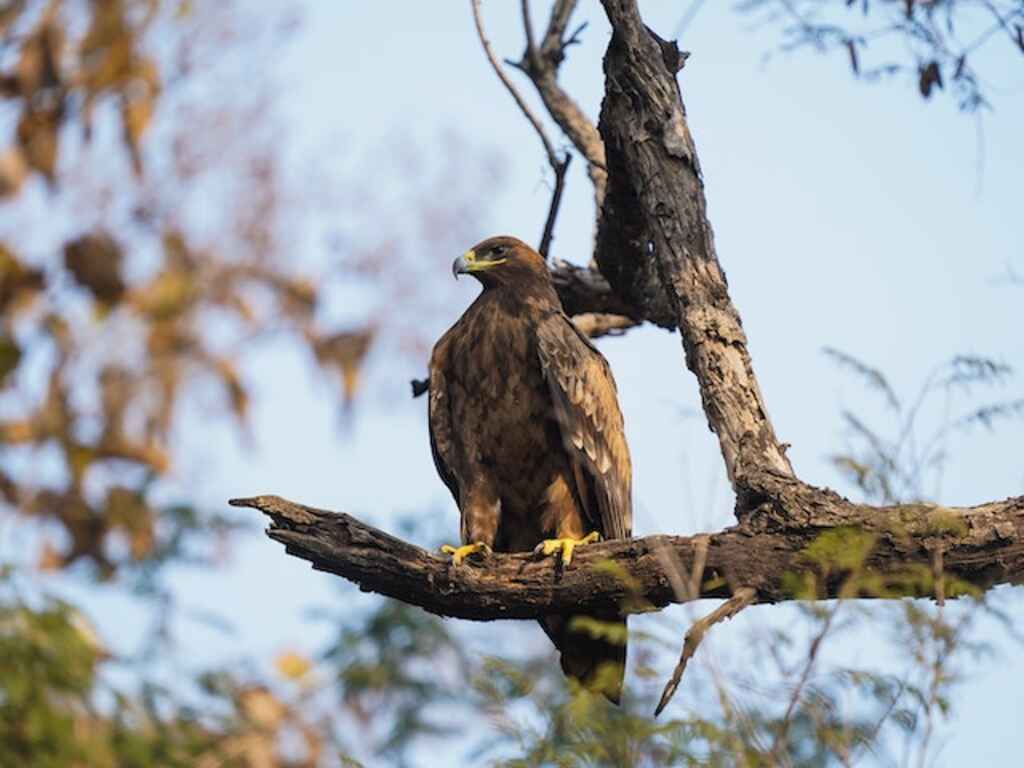
Adaptations and Defense Mechanisms
Adaptations and defense mechanisms allow eagles to efficiently exploit geese as a food source. Eagles have developed a range of adaptations for survival in order to successfully prey upon geese.
Firstly, their sharp, hooked beaks enable them to tear into the flesh of their prey. Additionally, eagles possess strong talons that allow them to grasp and immobilize geese during attacks.
These adaptations, coupled with the eagles’ powerful flight muscles, enable them to quickly and efficiently capture their prey.
In terms of defense mechanisms, geese have evolved to be highly alert and vocal, often sounding an alarm when danger is detected.
They also tend to gather in large flocks, which can confuse and deter predators.
Furthermore, geese are excellent swimmers, allowing them to escape into bodies of water where eagles have more difficulty catching them.
These adaptations and defense mechanisms contribute to the intricate predator-prey dynamics between eagles and geese. Factors influencing prey selection will be discussed in the subsequent section.
Factors Influencing Prey Selection
Adaptations and defense mechanisms play a crucial role in determining the success or failure of prey in evading predators.
However, in addition to these factors, there are various other elements that influence a predator’s selection of prey.
These factors can include the availability of alternative prey, the abundance and distribution of potential prey, as well as the predator’s own physiological and behavioral traits.
For instance, eagles, being opportunistic predators, may prefer geese as their prey due to their abundance in certain habitats.
Moreover, factors such as the size, behavior, and vulnerability of geese can also influence the eagles’ decision to target them.
Understanding the complex dynamics of predator-prey interactions and the factors affecting prey selection is essential in comprehending the intricate web of life in ecosystems.
This knowledge can provide valuable insights into the functioning and stability of natural communities.
Transitioning to the subsequent section on geographic variations in predation patterns, these factors may vary across different regions, leading to diverse prey preferences among eagles.
Geographic Variations in Predation Patterns
Geographic variations in predation patterns can result in diverse prey preferences among eagles, as different regions offer varying availability and distribution of potential prey.
These variations in predation rates are influenced by the specific habitat characteristics of each region.
Eagles adapt their hunting strategies based on the types of habitats they inhabit, which in turn affects their prey selection.
Factors such as the presence of water bodies, vegetation cover, and the abundance of suitable perching sites all play a role in shaping predation patterns.
Additionally, variations in prey species composition and abundance across different regions further contribute to the differences in eagle predation patterns.
Understanding these geographic variations in predation patterns and the influence of habitat on prey selection is crucial for effective conservation and management considerations.
By considering these factors, conservationists and managers can develop targeted strategies to protect both eagles and their prey populations.
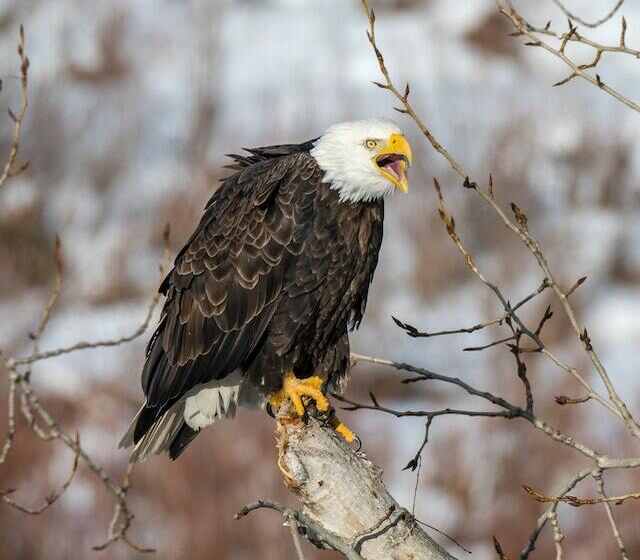
Conservation and Management Considerations
Conservation and management considerations in relation to the predation of geese by eagles involve the protection of both eagle and goose populations.
Efforts should be made to balance the needs of predators and prey in conservation endeavors, ensuring the long-term survival of both species.
Additionally, human interventions can be implemented to prevent predation on geese, such as the use of deterrents or altering the landscape to decrease the vulnerability of geese to eagle attacks.
Protection of eagle and goose populations
The coexistence of eagle and goose populations is a matter of concern as it pertains to safeguarding the survival and balance of these two species.
Geese conservation is crucial in maintaining their populations, as they provide important ecological functions such as seed dispersal and nutrient cycling.
On the other hand, understanding eagle population dynamics is essential for effective management and conservation efforts.
To protect both species, conservationists have implemented various strategies, including:
- Creating protected areas: Establishing protected areas for eagles and geese ensures the availability of suitable habitats and minimizes human disturbances.
- Monitoring populations: Regular monitoring of eagle and goose populations helps researchers understand their population trends and identify potential threats.
- Implementing hunting regulations: Carefully managing hunting activities can prevent overexploitation and ensure sustainable populations of both eagles and geese.
- Promoting public awareness and education: Educating the public about the importance of eagles and geese in ecosystems fosters support for their conservation.
The protection of eagle and goose populations is crucial for maintaining the ecological balance. Balancing the needs of predators and prey in conservation efforts requires a comprehensive understanding of their dynamics and the implementation of effective management strategies.
Balancing the needs of predators and prey in conservation efforts
Conservation efforts often involve the delicate task of balancing the needs of predators and prey.
In the case of eagles and geese, misconceptions about their interactions can complicate this process.
While it is true that eagles are opportunistic predators and may prey on geese, it is important to understand that this does not necessarily imply a threat to the overall goose population.
Research has shown that predation by eagles can actually benefit geese by removing weaker individuals and preventing overpopulation.
Therefore, a more nuanced approach is required when considering the protection of both eagle and goose populations.
Balancing conservation efforts means acknowledging the ecological role of predators and understanding that they play a crucial part in maintaining the health and balance of ecosystems.
To further explore this topic, it is important to consider the various human interventions aimed at preventing predation on geese.
Human interventions to prevent predation on geese
Human interventions aimed at preventing predation on geese often involve creative strategies such as employing decoy predators or implementing scare tactics to deter potential threats.
These interventions are designed to disrupt the predator-prey relationship and maintain ecosystem balance.
Decoy predators, such as life-sized replicas of eagles or other natural predators, can be strategically placed in areas frequented by geese to create the illusion of danger and discourage predation.
Scare tactics, such as loud noises or visual deterrents like reflective tape, can also be used to startle and deter potential predators.
Such interventions aim to protect geese populations from excessive predation while ensuring that natural predator-prey dynamics are not entirely disrupted.
However, it is important to note that these interventions should be carefully planned and monitored to avoid unintended consequences or disruptions to the overall ecosystem.
These human interventions are just one aspect of the complex dynamics involved in maintaining a balanced ecosystem.
Transitioning to the next section on misconceptions and myths, it is important to address common misunderstandings about the interactions between eagles and geese.

Misconceptions and Myths
This discussion will focus on common misconceptions about eagles and geese, debunking myths surrounding eagle predation on geese, and the scientific studies and evidence on this topic.
It is important to address these misconceptions and myths in order to provide accurate information and promote a better understanding of the dynamics between eagles and geese.
By examining scientific studies and evidence, we can gain a more objective perspective on the interactions between these two species.
Common misconceptions about eagles and geese
Contrary to popular belief, eagles and geese do not engage in predatory interactions as eagles primarily prey on fish and small mammals while geese are herbivorous and feed on aquatic plants.
One common misconception is that eagles hunt and feed on geese. However, this is not accurate as eagles have different dietary preferences.
Eagles are known for their excellent hunting skills and sharp talons, which they use to catch fish and small mammals such as rabbits and squirrels.
They are also opportunistic feeders and may scavenge on carrion. On the other hand, geese are primarily herbivores and rely on aquatic plants and grasses for their nutrition.
Therefore, the idea of eagles preying on geese is a misconception that needs to be debunked.
By understanding the distinct dietary habits of eagles and geese, we can dispel these myths surrounding eagle predation on geese without compromising the objective approach.
Debunking myths surrounding eagle predation on geese
In order to dispel misconceptions surrounding eagle predation on geese, it is important to analyze the distinct dietary preferences and behaviors of these two avian species.
Contrary to popular belief, eagles do not primarily prey on geese. While eagles are opportunistic hunters and will consume a variety of prey, geese are not a significant part of their diet.
This debunked myth likely stems from the occasional observation of eagles preying on geese, leading to an overgeneralization.
However, scientific studies and evidence on this topic reveal that eagles typically prefer fish, small mammals, and carrion as their main food sources.
Geese, on the other hand, are herbivorous birds and primarily feed on grasses, sedges, and aquatic plants.
Therefore, the eagle predation controversy surrounding geese can be attributed to a lack of understanding of their respective dietary preferences and behaviors.
Scientific studies and evidence on this topic
Scientific studies and evidence have shed light on the dietary preferences and behaviors of eagles and geese, revealing a stark contrast in their food sources.
Research has shown that eagles are primarily carnivorous, relying on a diet composed mainly of fish. They possess sharp talons and a hooked beak that are specialized for catching and consuming fish.
Conversely, geese are herbivorous birds that graze on a variety of plant matter, including grasses, leaves, and seeds.
While eagles may opportunistically prey on geese, especially during times of scarcity, it is not a common occurrence.
These findings indicate that eagles and geese have distinct dietary preferences, with eagles being primarily piscivorous and geese being herbivorous.
This scientific research contributes to our understanding of the ecological roles and interactions of these avian species.

Frequently Asked Questions
How do geese defend themselves against eagle attacks?
Geese defend themselves against eagle attacks by employing a range of techniques. They use their large size and aggressive behavior to intimidate eagles, form defensive formations, and emit loud honking sounds as a warning to other geese.
What are some common misconceptions about eagles and geese interactions?
Common misconceptions about eagle and goose interactions include the belief that eagles frequently prey on geese. However, while eagles are opportunistic predators, they primarily target smaller prey such as fish and rodents.
Are there any management strategies in place to protect geese from eagle predation?
Geese management strategies focus on controlling eagle predation. Measures include habitat modification, implementing deterrents, and employing non-lethal methods such as scare tactics and exclusion techniques. These strategies aim to minimize geese vulnerability and maintain their freedom from eagle predation.
What factors influence the selection of geese as prey for eagles?
Factors influencing the selection of geese as prey for eagles include habitat characteristics, such as open areas near water bodies where geese congregate. Eagle predation can have significant impacts on goose populations, affecting their abundance and distribution.
Do geese have any adaptations or defense mechanisms to avoid being caught by eagles?
Geese have evolved various adaptations and defense mechanisms to evade eagle predation. These include enhanced visual and auditory senses, flocking behavior, and rapid flight speeds, enabling them to escape the grasp of their formidable aerial predators.
Conclusion
In conclusion, the diet of eagles is diverse and includes a variety of prey, including geese.
Geese, on the other hand, exhibit specific behaviors and defense mechanisms to avoid predation by eagles.
Interactions between eagles and geese are influenced by factors such as habitat, prey availability, and predator-prey dynamics.
It is important to understand and study these interactions for conservation and management purposes.
Despite common misconceptions and myths, the predation of geese by eagles is a natural process that plays a crucial role in maintaining ecosystem balance.

